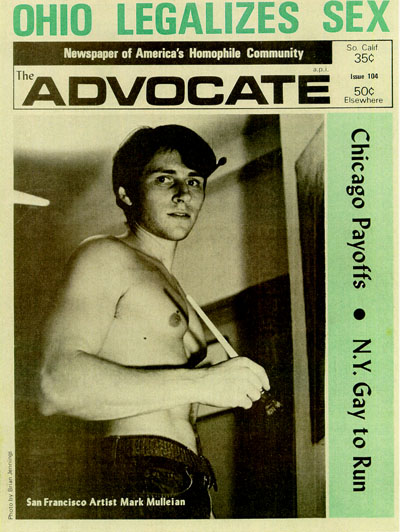To
read Advocate article Click on Media Coverage botton on Home page
It
is not often
that a single individual
can stir up such controversy, not only in challenging the art establishment
but also in regards
to his views on homosexuality. As an already
established artist in the U.S. since 1969, his political views and his strong
antinuclear,
environmental, and
gay rights positions helped open the doors in both the gay and straight cultures.
By bridging
the gap between
the homosexual and heterosexual communites, Mulleian has helped to promote
tolerance and understanding
through his work and through the media for over forty years on a national
and international scale.
In
January 1973, The
Advocate (a national political gay newspaper, the
biggest of its kind in the U.S.) published one of the biggest
feature stories on an individual of its day. Written by freelance writer
Brian Jennings, the article drew national attention
and generated fan mail throughout the U.S. The cover story was two full
pages dedicated to Mulleian's art and lifestyle, and
his controversial perspective relating to human rights and individual sexual
expression. It was in the area of homosexual expression
that Mulleian's outspoken views drew the attention of the FBI to the front door
of the artist's studio in an investigation into
his controversial and challenging commentary on aspects of fundamental social
values during the Nixon era and shortly after J. Edgar Hoover’s death in
1972.
This
cover story and the subsequent FBI investigation brought a national outpouring
of response by mail to the painter from the Gay community throughout the United
States that lasted for over four months. The predominant response from the public
was appreciation for Mulleian's courageous and liberating stance by his coming
out and speaking publicly in a national and international forum, bringing to
the forefront of public attention his homosexuality in a time and era were it
was dangerous, indeed illegal, to do so. Moreover, all this took place while
the homosexual culture in the United States was still underground.
Despite
the artist's outspoken observations of the national scene, his media attention
continued to climb for over three decades. This attention came not only from
mainstream media but also from the media of a newly emerging counterculture
that was finding its voice in what would later come to be thought of as a bridge
between the radical sensibilities of North Beach, (radical as perceived by the
status quo), and the dawning of a new age of personal expression and sexual
freedom. He was thought by many to be ahead of his time. Mulleian's art and
his avant-garde views created a unique relationship with the media of two cultures,
a relationship that was not only unprecedented but, indirectly, a testimony
to the universality of his work.
Two
weeks after the Advocate story broke, a similar two-page cover feature would
appear in the European equivalent of the Advocate, the German magazine Him,
a monthly periodical reaching a wide audience in Belgium, Denmark, England,
Italy, the Netherlands, Austria, Switzerland, Luxembourg and the United States.
Mulleian was twenty-five years old.
|
As
an already
established
artist in the U.S. Mulleian
was becoming
controversial. Not only
in his
art surrounding
his intense subject
matter, but now on his
views of homosexuality
that drew the
attention
of the FBI to the front door of the
artist's
studio.
|
As
a result of the Advocate article, Mulleian became one of the cornerstones of
the gay movement in helping gay men out of the closet in untold numbers throughout
America. The article brought many to San Francisco to visit with the artist
at the Frank Gallery on Gallery Row in appreciation of his insightful, inspirational
contribution to gay society.

